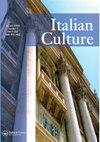Looking Sideways to Italy in Contemporary World Literature
IF 0.3
0 HUMANITIES, MULTIDISCIPLINARY
引用次数: 1
Abstract
This article sketches a history of how the concept of Italy has travelled worldwide to become a mobile cultural symbol in order to show how, as a signifier, “Italy” has also become increasingly detached from any national parameters of territory. It employs a lateral method of “looking sideways” at literary representations of Italy from “outside” the national canon to show how they can put pressure on what (and where) Italian culture now resides. Analyzing three contemporary works of world literature partially set in Italy (Daša Drndić’s Trieste, Rachel Kushner’s The Flamethrowers, and Pajtim Statovci’s Crossing), it suggests that we might consider broadening out the canon of transnational Italian literature to include works neither written by Italians nor written in Italian, but that offer sideways insight into Italian history and culture from elsewhere.当代世界文学中的意大利
这篇文章概述了意大利的概念是如何在世界范围内传播成为一个流动的文化符号的历史,以展示作为一个能指,“意大利”是如何越来越脱离任何国家领土参数的。它采用了一种横向的方法,从国家经典“之外”“侧面看”意大利的文学表现,以展示它们如何对意大利文化的现状(和位置)施加压力。通过分析三部部分以意大利为背景的当代世界文学作品(Daša drndiski的《的里雅斯特》,Rachel Kushner的《火焰的抛洒者》和Pajtim Statovci的《穿越》),我们可以考虑扩大意大利跨国文学的标准,包括既不是意大利人写的也不是用意大利语写的作品,但这些作品可以从其他地方侧面洞察意大利的历史和文化。
本文章由计算机程序翻译,如有差异,请以英文原文为准。
求助全文
约1分钟内获得全文
求助全文

 求助内容:
求助内容: 应助结果提醒方式:
应助结果提醒方式:


